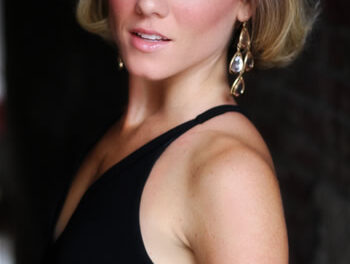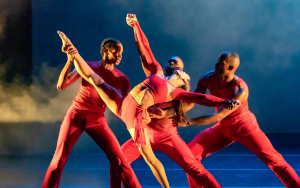On April 3, the eve of Holy Week, the Duke Chapel Choir departed from the norm – insofar as its annual spring oratorio is concerned – and offered four short works focusing, more or less, on the Passion of Christ. The pieces – Liszt’s Via Crucis , S.53 (1878), Verdi’s “Stabat Mater” (1896-7), Mendelssohn’s “Hear My Prayer” (1844), and Stravinsky’s Symphony of Psalms (1930) – are all over the stylistic map but, as Sue T. Klausmeyer’s erudite notes reveal, the “drama and pathos” they contain and can convey begin with events associated with Good Friday and extend through the praises customarily rendered on Easter Sunday and beyond for Christians’ hoped-for salvation. The Chapel Choir’s 100 or so members sang from risers in the transept of the awe-inspiring building, the men grouped together, flanked by women. The choral soloists in the Liszt, to which the first half of the program was devoted, and which was accompanied, mostly alternately, by both of the Chapel’s great organs, stood immediately forward of their colleagues; guest soloist Penelope Jensen performed in the Mendelssohn to the left of conductor Rodney Wynkoop. The orchestral accompaniments for the three works given in the second half were as varied as the styles of the scores themselves.
Via Crucis (The Way of the Cross , sometimes called The Stations of the Cross) is a late work, stark and severe in keeping with its subject matter. Liszt kept his accompaniment to a minimum, often limiting the music to single lines that can, at first hearing, seem to meander. There was method to this apparent madness, and the result is in effect a religious service, set to music, starting with SATB soloists (Patricia D. Philipps, Amy Kirkhum, Wade N. Henderson, and Matthew Fry) and a chorus singing of the fulfillment of prophecy. The fourteen stations are then addressed in turn by various vocal and instrumental forces, ranging from soloists – bassos Thomas Emerson Link and Matthew Fry and alto Megan M. Gray – to a cappella men and women to solo organ passages (including frequent introductions and postludes, of varying lengths and intensities). The organists were David Arcus (Aeolian) and Robert Parkins (Flentrop), and hearing the two instruments antiphonally was one of the afternoon’s many delights; it was not the first time both have been played in the same work, but it was something of a rarity. The Abbe Liszt was as famous for his spirituality as he was for his flamboyant pianism and his ability to splash tone color with the abandon of some contemporary painters. Via Crucis is laden with the former quality to the point of near-mysticism and graced by sufficient hints of the latter – generally in the organ preludes and postludes – to remind listeners that this is a major work from the pen of a confirmed master, but it is not the sort of thing people turn to for casual listening. For that reason, hearing it in Duke Chapel at this time in the church year was ideal, and it is therefore good to be able to report that the choir handled the music altogether admirably. The women outnumber the men by something like 2:1, but the gents discharged their portions with distinction. There was strength in numbers among the women, too, and only occasionally did one long for somewhat greater maturity from the sopranos – there are some townies among the student members, but this is mostly a student ensemble, built up by one of our region’s finest directors. It may be worth noting that Via Crucis exists in several versions with differing accompaniment; the edition presented on this occasion worked as well as any I have heard, live or on records, and better than most. The opening chorus rode on great waves of organ sound from the front of the Chapel, the Flentrop punctuated the stations assigned to it with considerable drama, and between them the very floor of the building shook from time to time. There are few recognizable tunes in the piece, but a clear reference to the Dresden Amen (also quoted in son-in-law Richard Wagner’s Parsifal ) added immeasurably to the musical and spiritual impact of the performance. And Liszt the master composer was elsewhere much in evidence – one example being the upward motion (toward heaven) of the vocal parts and their respective lines at the end of the piece.
Verdi’s last work, the “Stabat Mater,” is a much more accessible score, although its text – part of which also appears in Via Crucis – is no less mournful. Still, it is accompanied by a large orchestra, and Verdi’s mastery of drama, which exceeded even Liszt’s (although fans of the latter’s operas and oratorios may dispute that claim), give the short (13 minute) work both impact and immediate appeal. It is part of the set of Four Sacred Pieces that include the better-known Te Deum, which has been performed locally several times, although not in the recent past. Because it is more overtly dramatic than the Liszt, the lack of quasi-operatic voices in the choir, and especially among the sopranos, was more evident here, but overall the performance was a strong one, high on technical precision and invested with considerable emotion. Concertmaster Paul Gorski headed the 65-member orchestra, which included some of our finest regional artists. The floor shaking in this number came from the low brass and strings in passages that hinted at the much larger Manzoni Requiem .
A different aspect of spirituality came in Mendelssohn’s “Hear My Prayer,” a hymn for soprano and choir. Jensen is one of our most angelic soloists, and she soared ethereally in the work’s many high passages; her performances of the lower sections, while not anywhere near as powerful, were likewise touched by her superior interpretive skills and thus – from not too far away – made comparably powerful impacts on this listener. The contrast in the orchestral work, compared with the Verdi, was marked; surely the large audience must have been moved and impressed, too, with the remarkable variety in the compositions offered.
The first line of the grand finale, Stravinsky’s Symphony of Psalms, anchored it to the Mendelssohn, in a manner of speaking, since it begins with the words “Hear my prayer….” It written for the 50th anniversary of the Boston Symphony Orchestra, and it’s a safe bet that the commissioners were hard-pressed to know what to make of it. Even today, it’s something of a challenge to listeners, for hearing parts of two Psalms (Ps. XXXIX and Ps. XL) and all of Ps. CL wrapped in music that evokes, alternately, Rite of Spring (although the orchestra is without violins and violas) and Les Noces (although there are only two pianos, played at Duke by composer Anthony Kelley and Chapel Organist Arcus) remains a tough sell. That said, the Alleluias suggest settings by Poulenc and thus help keep the audience focused on the texts’ messages. The Chapel Choir’s accomplishments in this stark, forceful music were remarkable in every respect, and the performance, which made a strong case for the work, earned extended applause.












